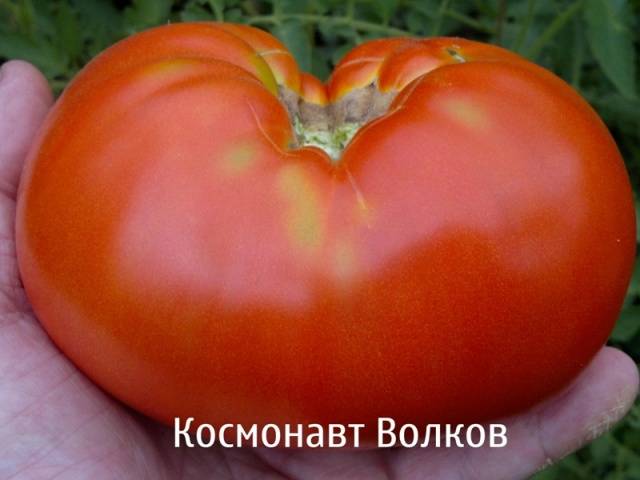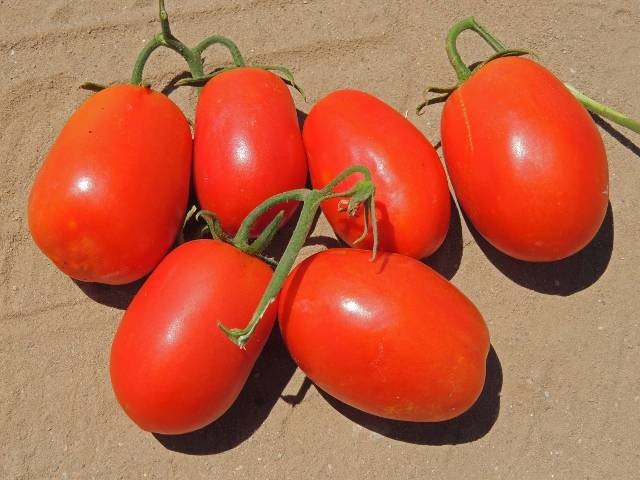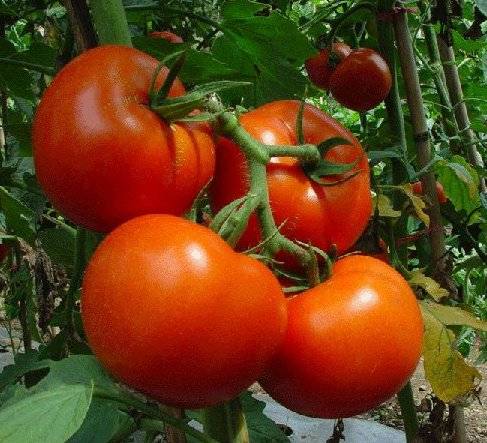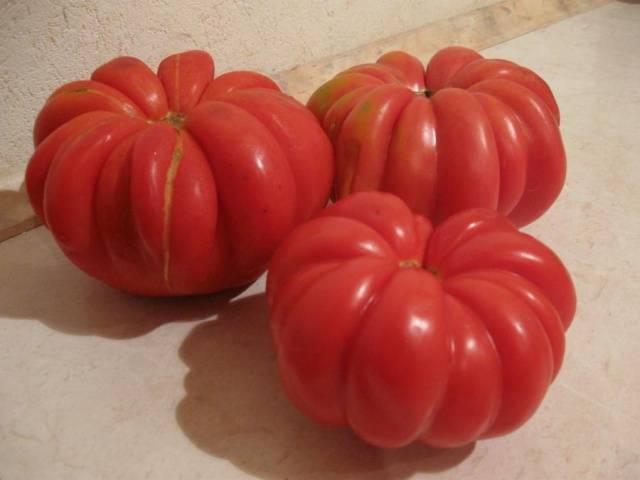Content
- 1 Features of late varieties
- 2 Rules for planting and caring for late tomato seedlings
- 3 Review of late varieties of tomatoes for open ground
- 3.1 Brown sugar
- 3.2 Sis F 1
- 3.3 Octopus F1
- 3.4 De Barao
- 3.5 Lezhky
- 3.6 Khutorskoy salting
- 3.7 Cosmonaut Volkov
- 3.8 Rio grand
- 3.9 Titanium
- 3.10 Date fruit
- 3.11 Scorpion
- 3.12 Bull's heart
- 3.13 Giraffe
- 3.14 Supergiant F1 XXL
- 3.15 Finish
- 3.16 Cherry
- 3.17 Snowfall F1
- 3.18 St. Andrew's surprise
- 3.19 Long keeper
- 3.20 New Year
- 3.21 American ribbed
- 3.22 Altai F1
- 4 Conclusion
Popularity early tomatoes among summer residents it is due to the desire to get their vegetable harvest by the end of June, when it is still expensive in the store. However, the fruits of late-ripening varieties are more suitable for canning, as well as other winter preparations, and there is no way to do without them. Today we will touch on the topic of late varieties of tomatoes for open ground, learn their characteristics, and get acquainted with the best representatives of this culture.
Features of late varieties
Comparing the characteristics of late tomatoes with their early or mid-ripening counterparts, it can be noted that the yield of the former is slightly lower. However, the quality of the fruit of a late-ripening crop has its superiority. Tomatoes are distinguished by excellent taste, aroma, meatiness and are richly saturated with juice. The fruits of late-ripening tomatoes, depending on the variety, come in different colors, shapes and weights. The peculiarity of late varieties is the possibility of growing them without seedlings.At the time of sowing the seeds, the soil is already sufficiently warmed up and the grains are immediately immersed in the soil at their permanent place of growth.
Some varieties of tomatoes, such as Long Keeper, can last in the basement until March.
Another feature of late varieties of tomatoes is the possibility of growing them in beds after harvesting early crops or green salads. In this case, it is better to resort to growing seedlings in order to have time to harvest more crops before the onset of frost. Sowing of seeds begins after March 10. Under sunlight, seedlings grow strong and not elongated.
As for the height of the bushes, most of the late varieties belong to the indeterminate group of tomatoes. Plants grow with very long stems of 1.5 m and above. For example, the tomato bush “Cosmonaut Volkov” reaches a height of 2 m, and the “De Barao” variety can stretch up to 4 m without pinching. Of course, they are found among late varieties and determinate tomatoes with limited stem growth. For example, a Titan tomato bush is limited to a height of 40 cm, and a Rio Grande tomato plant extends to a maximum of 1 m.
Indeterminate varieties, as well as hybrids, will produce the best yield in a greenhouse.
Rules for planting and caring for late tomato seedlings
When growing late tomatoes with seedlings, plants are planted in open beds in mid-summer, when the weather is hot outside.When heated by the sun's rays, moisture quickly evaporates from the soil, and in order for the plant to survive in such conditions, it must have a well-developed root system at the time of planting. We must not forget about timely watering, and by the end of the hot days, the stronger plants will throw out the first inflorescences.
When caring for planted seedlings, you must adhere to the following rules:
- The soil around the plants must be constantly loosened. You will definitely need to fertilize, and don’t forget about pest control. Perform pinching in a timely manner if the variety requires it.
- The development of seedlings is adversely affected by the resulting earthen crust, which disrupts the water, temperature and oxygen balance within the soil. A thin layer of peat or humus scattered over fluffy soil will help to avoid this. Alternatively, even ordinary straw will do.
- The first feeding of seedlings is carried out 2 weeks after they are planted in the garden. The solution can be prepared at home from 10 g of ammonium nitrate and 15 g of superphosphate, diluted in 10 liters of water.
- When the first ovary appears on the plants, they must be treated with the same solution, only instead of 15 g of superphosphate, take a similar proportion of potassium sulfate.
- Organic fertilizing from bird droppings diluted in water will help increase crop yields. Just be careful not to overdo it so as not to burn the plant.
By following a few simple rules in the garden, you will be able to grow a good harvest of late-ripening tomatoes.
The video shows tomato varieties for open ground:
Review of late varieties of tomatoes for open ground
Late-ripening tomato varieties are considered to be crops that bear fruit 4 months after seed germination.Typically, in a garden, up to 10% of the plot in a garden bed intended for the general cultivation of tomatoes of different ripening periods is allocated for late tomatoes.
Brown sugar
The unusual color of the tomato is considered medicinal. The substances contained in the pulp help the human body fight cancer and cardiovascular diseases. Medicinal properties are present only in freshly squeezed juice. For regular consumption, the vegetable is used in canning and other types of processing.
The stems of the plant are tall and are not able to support the weight of the fruit on their own, so they are fixed on trellises. Tomatoes grow in a regular round shape, weighing up to 150 g. The full maturity of the fruit is determined by the dark brown color of the pulp. Sometimes the skin may take on a burgundy tint.
Sis F 1
This hybrid will appeal to lovers of medium-sized fruits, convenient for canning in jars. The maximum weight of a ripe tomato reaches 80 g. The vegetable is slightly elongated, and there is slight ribbing along the walls. The harvest ripens no earlier than after 4 months. Picked tomatoes can be stored for a long time, but it is better to keep them indoors. In the cold, for example, in the refrigerator, the vegetable deteriorates its taste.
Octopus F1
The hybrid was bred by breeders as a tomato tree. In industrial greenhouses, the plant reaches enormous sizes and bears fruit for a very long time, bearing up to 14 thousand fruits. On open the tree will not grow in the ground, but the result will be an ordinary tall tomato. The plant will need at least twice a day of feeding and tying to the trellis. Tomatoes are formed in clusters. Fruit ripening begins 4 months after germination.The advantage of the hybrid is its resistance to viruses when grown outdoors.
De Barao
The variety, which has long been popular among gardeners, has several subspecies. The characteristics of tomatoes are almost the same, only the color of the fruit differs. It is very convenient to grow your favorite tomato on the plot, for example, with yellow and pink fruits. Typically, vegetable growers plant 3 bushes that produce tomatoes of different colors. The stems of the plant are very long, and if the tops are not pinched, they can grow up to 4 m in height. To tie them up you will need a large trellis. Ripe fruits are small, weighing a maximum of 70 g, which makes them popular for whole preservation in jars.
Lezhky
By the name of the variety you can judge the possibility of long-term storage of tomatoes. The collected unripe fruits will arrive in time for the New Year holidays. The plant bears fruit well in open ground, producing 7 fruits in each cluster. The maximum height of the bush is 0.7 m. Fruits with strong skin and dense pulp do not tend to crack. The weight of a mature vegetable reaches 120 g.
Khutorskoy salting
Every housewife will like tomatoes of this variety, as they are ideal for pickling and canning. Even after heat treatment, the skin of the fruit does not crack, and the flesh retains its density and crunch, unusual for a tomato. Orange fruits weigh about 110 g. Using as a secondary crop, tomato can be planted after harvesting greens, early cucumbers or cauliflower. The indeterminate bush grows up to 2 m in height. From 1 m2 An open bed can yield up to 7.5 kg of harvest.
Cosmonaut Volkov
You can get the first fruits from the plant after 115 days. This defines the tomato as being closer to mid-late varieties, but it can also be called late.Several bushes of this variety are planted in the home garden, since its fruits are only intended for salad purposes and are not used for canning. The plant, 2 m high, grows powerful, but practically not spreading. The main stem is tied to the trellis, and the excess stepsons are removed. The ovary is formed in clusters of 3 tomatoes each. Ripe tomatoes are large, sometimes reaching a weight of 300 g. During the season, the bush is capable of producing 6 kg of tomatoes. The walls of the vegetable have weak ribbing.
Rio grand
Like all late tomatoes, the crop is ready to produce its first ripe fruits after 4 months. The plant is considered determinate, but the bush is very developed and grows up to 1 m in height. The shape of the fruit resembles something between an oval and a square. A mature tomato weighs about 140 g. The crop does not require special care and easily tolerates temperature fluctuations. The vegetable is used in different directions and tolerates transportation well.
Titanium
A low-growing crop will delight you with the first tomatoes only after 130 days. A determinate plant will grow to a maximum height of 40 cm. Red fruits grow evenly round, weighing up to 140 g. Smooth skin with dense pulp does not crack. The vegetable is delicious in any form.
Date fruit
The variety will attract the attention of lovers of very small tomatoes. Small, slightly elongated fruits weigh only 20 g, but in terms of taste they can compete with many southern varieties. From a distance, a tomato looks a little like a date. The yellow pulp is highly saturated with sugar. The plant is powerful; the formed clusters bear a maximum of 8 fruits.
Scorpion
The tomato variety is adapted for cultivation in open and closed ground. The tall plant bears beautiful raspberry-colored fruits.The tomato has a classic round shape, the area near the stalk and opposite it is slightly flattened. The fruits grow large, some specimens weigh up to 430 g. The dense pulp contains few grains. The crop is famous for its stable fruiting and high yield.
Bull's heart
The traditional representative of late tomatoes will bear fruit in 120 days. The main stem grows up to 2 m in height, but the plant itself is sparsely covered with foliage, which allows sunlight and fresh air to penetrate inside the bush. Thanks to this, the crop is less susceptible to late blight. Like all tall tomatoes, the plant needs to be secured to a trellis and pinched. Very large heart-shaped fruits grow weighing 400 g. Tomatoes weighing up to 1 kg can ripen on the lower tier. Due to its large size, the vegetable is not used for canning. Its purpose is salads and processing.
Giraffe
This variety will need at least 130 days to please the grower with ripe tomatoes. The tall bush is capable of bearing fruit in open and closed plots of land. The stem itself will not be able to support the entire mass of the crop, so it is tied to a trellis or any other support. The color of the fruit is somewhere between yellow and orange. Maximum weight 130 g. During the entire growing season, about 5 kg of tomatoes are plucked from the plant. The vegetable can be stored for six months.
Supergiant F1 XXL
The hybrid will appeal to lovers of large tomatoes. The plant can bear gigantic fruits weighing up to 2 kg without special care. The value of the hybrid is only in the taste of the tomato. From the sweet, fleshy pulp you can prepare juice and lots of fresh food. Naturally, the vegetable is not suitable for canning.
Finish
A tomato is considered fully ripe at the beginning of the 5th month. Culture is considered determinant. The bush grows up to 75 cm in height, the stem and side shoots are sparsely covered with foliage. The red, dense flesh is covered with a smooth skin, on which an orange tint is visible. Round tomatoes weigh only 90 g. Stable fruiting is observed throughout the entire growing season.
Cherry
A decorative variety of tomatoes will decorate not only the area near the house or balcony, but even winter storage. Small tomatoes are rolled whole into jars without picking them from the bunch. Very sweet fruits weigh only 20 g. Sometimes specimens weighing 30 g are found.
Snowfall F1
The hybrid produces a harvest after 125–150 days. The plant is indeterminate, although the height of the bush does not exceed 1.2 m. The crop is not afraid of sudden changes in temperature, and is able to bear fruit until the end of November until stable frosts occur. The yield is up to 4 kg of tomatoes per plant. The round, dense fruits do not crack, the maximum weight is 75 g. The hybrid has taken root well in the Krasnodar region.
St. Andrew's surprise
The plant has a high main stem up to 2 m. Tomatoes grow large, weighing 400 g. Even larger tomatoes weighing up to 600 g can grow from below on the plant. The indeterminate culture is weakly affected by common diseases. Despite the abundance of juice, the pulp does not tend to crack. The vegetable is used for processing and making salads.
Long keeper
Bushes of this late variety grow to a maximum of 1.5 m in height. Round, slightly flattened tomatoes weigh about 150 g. The crop is grown in open ground, but you won’t be able to wait for ripe fruits on the plant.All tomatoes are picked green in late autumn and stored in the basement where they are grown. ripening. The only exception may be the fruits of the lower tier, which manage to acquire a red-orange color on the plant. The yield indicator is 6 kg per plant.
New Year
The plant grows up to 1.5 m in height. The first tomatoes ripen on the lower clusters no earlier than September. The yellow fruits are usually round, sometimes slightly elongated. A mature vegetable weighs no more than 250 g, although specimens weighing 150 g are more common. A fairly high yield allows you to get up to 6 kg of tomatoes per plant. Harvesting of the entire harvest begins in the third ten days of September. All semi-ripe vegetables are stored in the basement, where they ripen.
American ribbed
The standard crop will please the vegetable grower with a harvest in about 125 days. A determinate plant is rarely affected by the main types of diseases. The red fruits are strongly flattened, with characteristically pronounced ribs on the walls. The average weight of a mature tomato is about 250 g, sometimes larger specimens weighing up to 400 g grow. There are up to 7 seed chambers inside the pulp. Ripe tomatoes cannot be stored for long periods of time; it is better to immediately put them into processing or simply eat them. The bush is capable of producing up to 3 kg of vegetables. If you stick to a planting density of 3 or 4 plants per 1 m2, you can get 12 kg of harvest from such a plot.
This video talks about American varieties of tomatoes:
Altai F1
Fruit ripening in this hybrid is observed after 115 days. The indeterminate plant grows up to 1.5 m in height. The bush is medium covered with large dark green leaves. Fruit set occurs in clusters of 6 tomatoes each. The fruiting period is long until the onset of the first frost. The average weight of a ripe vegetable is about 300 g, but larger fruits weighing up to 500 g are found. The tomatoes are slightly flattened, smooth on top, and faint ribbing appears near the stalk. Inside the pulp there can be up to 6 seed chambers. The skin of the vegetable is quite thin, but so strong that it protects the pulp from cracking. The hybrid has several varieties, differing in the color of ripe fruits: red, pink and orange.
Conclusion
All late hybrids and varieties of tomatoes grown in open ground have an amazing taste, as well as a delicate aroma thanks to the sun, fresh air, and warm summer rain.































Giraffe tomatoes were planted once and ripened all winter; the last ones were eaten at the end of March.